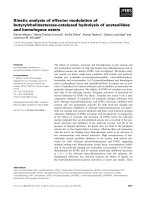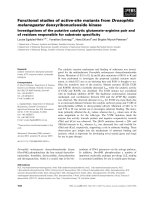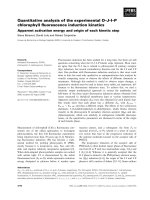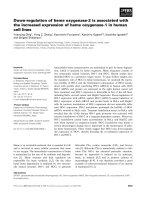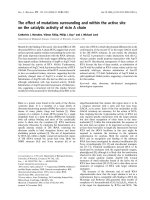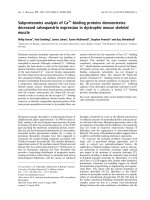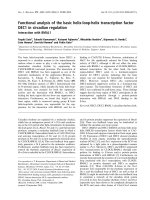Báo cáo khoa học: Functional analysis of mutations in UDP-galactose-4epimerase (GALE) associated with galactosemia in Korean patients using mammalian GALE-null cells pdf
Bạn đang xem bản rút gọn của tài liệu. Xem và tải ngay bản đầy đủ của tài liệu tại đây (553.93 KB, 10 trang )
Functional analysis of mutations in UDP-galactose-4-
epimerase (GALE) associated with galactosemia in Korean
patients using mammalian GALE-null cells
You-Lim Bang
1,
*, Trang T. T. Nguyen
1,
*, Tram T. B. Trinh
1,
*, Yun J. Kim
1
, Junghan Song
2
and
Young-Han Song
1
1 Ilsong Institute of Life Science, Hallym University, Anyang, Korea
2 Department of Laboratory Medicine, Seoul National University Bundang Hospital, Gyeonggi-do, Korea
Galactose is metabolized by three enzymes: galactokin-
ase, galactose 1-phosphate uridyltransferase and UDP-
galactose-4-epimerase (GALE; EC 5.1.3.2) [1]. Defects
in any of these enzymes lead to the autosomal reces-
sive disorder, galactosemia [2]. The majority of
patients with GALE-deficiency galactosemia
(MIM 230350) are identified as having a clinically
benign ‘peripheral’ condition. These patients show
defective GALE activity only in circulating red and
white blood cells, and the condition is relatively com-
mon in African Americans [3] and in Japanese [4]. The
clinically severe ‘generalized’ form of GALE-deficiency,
galactosemia, is extremely rare and enzyme activity is
defective in all tissues examined. These patients show
growth retardation and developmental delay [5]. ‘Inter-
mediate GALE deficiency’ has also been applied to
patients who exhibit partial impairment of GALE
activity in nonperipheral cells, such as lymphoblasts
[6]. The molecular mechanisms that distinguish these
subtypes of GALE-deficiency galactosemia have not
been identified.
GALE is a member of the short-chain dehydroge-
nase ⁄ reductase superfamily. It is widely distributed in
nature and has been isolated and characterized in
several species [7–9]. The 3D structure of Escherichia
coli [10], Trypanosoma brucei [11], Saccharomyces
Keywords
galactosemia; mutation; protein aggregation;
UDP-galactose-4-epimerase; unstable
protein
Correspondence
Y H. Song, Ilsong Institute of Life Science,
Hallym University, 1605-4 Gwanyang-dong,
Dongan-gu, Anyang, Gyeonggi-do 431 060,
Korea
Fax: +82 31 388 3427
Tel: +82 31 380 1897
E-mail:
*These authors contributed equally to this
work
(Received 15 December 2008, revised 19
January 2009, accepted 21 January 2009)
doi:10.1111/j.1742-4658.2009.06922.x
Galactosemia is caused by defects in the galactose metabolic pathway,
which consists of three enzymes, including UDP-galactose-4-epimerase
(GALE). We previously reported nine mutations in Korean patients with
epimerase-deficiency galactosemia. In order to determine the functional
consequences of these mutations, we expressed wild-type and mutant
GALE proteins in 293T cells. GALE
E165K
and GALE
W336X
proteins were
unstable, had reduced half-life, formed aggregates and were partly
degraded by the proteasome complex. When expressed in GALE-null ldlD
cells GALE
E165K
, GALE
R239W
, GALE
G302D
and GALE
W336X
had no
detectable enzyme activity, although substantial amounts of protein were
detected in western blots. The relative activities of other mutants were
lower than that of wild-type. In addition, unlike wild-type, GALE
R239W
and GALE
G302D
were not able to rescue galactose-sensitive cell prolifera-
tion when stably expressed in ldlD cells. The four inactive mutant proteins
did not show defects in dimerization or affect the activity of other mutant
alleles identified in patients. Our observations show that altered protein
stability is due to misfolding and that loss or reduction of enzyme activity
is responsible for the molecular defects underlying GALE-deficiency
galactosemia.
Abbreviations
BrdU, bromodeoxyuridine; CHO, Chinese hamster ovary; EGFP, enhanced green fluorescent protein; GALE, UDP-galactose 4¢-epimerase;
UDP-galNAc, UDP-N-acetylgalactosamine; UDP-glcNAc, UDP-N-acetylglucosamine.
1952 FEBS Journal 276 (2009) 1952–1961 ª 2009 The Authors Journal compilation ª 2009 FEBS
cerevisiae [12] and human [13] GALE has been
determined by high-resolution X-ray crystallography.
GALE from all species examined to date, with the
exception of the bacterium, Aeromonas hydrophila
functions as a dimer [14]. Since the cloning of
human GALE in 1995 [15], 22 mutations have been
identified in the GALE coding sequences of GALE-
deficiency galactosemia patients (Fig. S1A) [5,6,16–
21]. To understand the functional consequences of
the mutations, biochemical studies have been carried
out by expressing wild-type and mutant human
GALE in bacteria or in yeast null for the GALE
homologue, gal10p. Among the 12 mutants charac-
terized to date, the most severe defects in GALE
protein were observed with mutants G90E, V94M
and L183P. Mutants G90E and V94M show a reduc-
tion in turnover number by factors of 800 and 30,
respectively [22], and are unable to restore galactose-
sensitive growth when expressed in epimerase-null
yeast [18]. Even though the turnover number of
mutant L183P is lower than that of wild-type GALE
by a factor of three [22], the relative abundance of
this mutant protein was greatly reduced in bacteria
[22] and yeast [23], thereby decreasing the relative
enzymatic activity to 4% of wild-type protein [23].
Mutants N34S, P293L and G319E show the mildest
defects in turnover number (reduced by factors of
1.1, 1.8 and 1.2, respectively) [22]. The remainder of
the mutant alleles characterized to date do not show
substantial defects in the restoration of galactose-
sensitive growth in yeast [21,24] and show a mild
reduction in turnover number (decrease by a factor
of 2.4–7.2) [22]. None of the mutant human GALE
tested to date show defects in dimerization [21,22]
and mutant alleles N34S and L183P are dominant
negative with respect to each other [23]. These results
suggest that not all mutant alleles found in
patients cause functional defects and underscore the
importance of functional studies on the mutant
proteins.
We previously described nine GALE mutations in
Korean patients with GALE-deficient galactosemia
[20]. These GALE mutations were novel with the
exception of R335H, which had been shown earlier to
cause mild defects in enzyme activity [19,22]. In this
study we generated expression plasmids containing
wild-type and mutant GALE cDNA from Korean
galactosemia patients and expressed the constructs in
293T or GALE null ldlD cells [25] to examine the
functional consequences of the mutations. Our study
showed that GALE
E165K
, GALE
R239W
, GALE
G302D
and GALE
W336X
exhibited no detectable enzyme activ-
ity, and GALE
E165K
and GALE
W336X
formed protein
aggregates and showed greatly reduced stability. More-
over, unlike wild-type proteins, the two stable inactive
mutants, GALE
R239W
and GALE
G302D
, were unable
to rescue defects in galactose-sensitive cell prolifera-
tion, confirming that these mutants are not functional
in vivo either.
Results
Protein stability
To investigate the functional properties of the mutant
GALE proteins, full-length wild-type or mutant GALE
cDNAs were cloned into expression plasmids containing
N-terminal myc or FLAG epitopes. When transiently
expressed in 293T cells, steady-state levels of myc–
GALE
E165K
and myc–GALE
W336X
proteins were signifi-
cantly reduced compared with wild-type, even though
the transfection efficiencies, based on the expression
level of cotransfected enhanced green fluorescent protein
(EGFP), were comparable (Fig. 1A). The steady-state
levels of FLAG-tagged GALE
E165K
and GALE
W336X
were similarly reduced (data not shown).
The steady-state protein level can be decreased by
mutations because of reductions in either RNA or pro-
tein stability. In order to distinguish between the two
possibilities, we performed semi-quantitative RT-PCR
using GALE transgene-specific primers and EGFP as
both an internal control and control for transfection
efficiency. The amount of PCR product increased upon
addition of threefold more cDNA template, confirming
that a plateau was not reached under these PCR con-
ditions. The levels of GALE
E165K
and GALE
W336X
transcripts were not significantly different from that of
wild-type, suggesting that these mutations did not alter
RNA stability (Fig. 1B).
We tested the stability of the mutant proteins by
determining protein half-life using cycloheximide.
Wild-type GALE produced stable protein with a half-
life of > 8 h. Unlike that of wild-type, the half-life of
GALE
E165K
and GALE
W336X
proteins decreased to 2.0
and 2.1 h, respectively (Fig. 1C). In order to determine
whether the mutant proteins are degraded by the
proteasome complex, we investigated the effect of
the proteasome inhibitor, MG132 on protein half-life.
In the presence of MG132, the half-lives of
GALE
E165K
and GALE
W336X
were increased signi-
ficantly up to 8.7 and 6.7 h, respectively, but MG132
treatment does not appear to restore the steady-state
protein level to that of wild-type (Fig. 1D). These
results suggest that GALE
E165K
and GALE
W336X
are unstable proteins which are degraded to some
extent by the proteasome complex.
Y L. Bang et al. Functional analysis of GALE mutation in ldlD cells
FEBS Journal 276 (2009) 1952–1961 ª 2009 The Authors Journal compilation ª 2009 FEBS 1953
Subcellular localization
We performed indirect immunofluorescence to deter-
mine whether the subcellular localization of GALE is
altered by the mutations. Wild-type GALE showed a
pattern of diffuse cytoplasmic immunoreactivity when
expressed in 293T cells (Fig. 2A). Mutant proteins
showed a distribution pattern similar to wild-type
(data not shown), with the exception of GALE
E165K
and GALE
W336X
, which formed perinuclear
A
B
C
D
Fig. 1. GALE
E165K
and GALE
W336X
proteins have shorter half-lives and are degraded by proteasome complex. (A, B) Empty vector ()), wild-
type (WT) or mutant myc–GALE expression plasmids were co-transfected into 293T cells with EGFP expression construct as a control for
transfection efficiency. Forty hours after transfection, cell lysates or total RNA were prepared and western analysis (A) or RT-PCR (B),
respectively, were carried out. (A) Myc–GALE and EGFP were detected using antibodies against myc and GFP by western analysis. (B) Equal
amount of total RNA prepared from transfected cells was reverse transcribed and 1 or 3 lL of cDNA was used to amplify EGFP and
myc–GALE. (C) In order to determine the half-life of myc–GALE
wt
, myc–GALE
E165K
and myc–GALE
W336X
proteins, 293T cells transiently
transfected with each myc–GALE expression plasmid were equally divided among the wells of a six-well plate and treated with 50 lgÆmL
)1
cycloheximide (CHX). At the indicated time intervals, the cells were harvested and analyzed by western blotting. The amount of extract from
cells expressing mutant GALE was increased to reach a detectable level of protein. Tubulin serves as a loading control. The relative amount
of mutant protein was calculated based on the ratio of the band intensities of myc-GALE to tubulin in the western blot and indicated below
the blot with 100 set as the zero time point. The relative levels of myc–GALE protein at each time point were plotted using a complete linear
least squares curve-fit algorithm, and the time point at which GALE levels decreased to 50% of their original value was determined and
reported as the half-life. (D) In parallel experiments, cells were treated with 25 l
M of the proteosome inhibitor, MG132, 1 h prior to and for
the duration of cycloheximide treatment.
Functional analysis of GALE mutation in ldlD cells Y L. Bang et al.
1954 FEBS Journal 276 (2009) 1952–1961 ª 2009 The Authors Journal compilation ª 2009 FEBS
aggregates. The appearance of the aggregates varied
and presented as a single, large perinuclear sphere, sev-
eral smaller spheres or perinuclear aggregates with
additional, multiple foci throughout the cytoplasm
(Fig. 2A). In some cells, the mutant proteins were also
observed in the cytoplasm, as seen for the wild-type
protein. Similar staining patterns were observed in
other human cell lines, including hepatoma Hep3B
cells and fibroblast 2fTGH cells (data not shown), sug-
gesting that mislocalization of the mutant proteins was
not cell-type-specific. Aggresomes are structures
formed in the presence of misfolded proteins and con-
tain components of the protein degradation and refold-
ing machinery, including proteasome complexes and
members of the Hsc70 and Hsp70 families of proteins
[26,27]. Because the morphological appearance of
aggresomes is similar to the aggregates seen in cells
expressing mutant GALE, we investigated whether
Hsc70 is recruited to the GALE
E165K
and GALE
W336X
aggregates. Unlike cells expressing wild-type GALE,
cells transfected with GALE
E165K
and GALE
W336X
showed Hsc70 redistribution and Hsc70 colocalized
with the GALE proteins, suggesting that these
mutant proteins indeed become incorporated into
aggresomes.
GALE activity towards UDP-galactose
To determine the functional consequences of the muta-
tions, we expressed wild-type and mutant GALE in
the GALE-null cell line, ldlD, derived from Chinese
hamster ovary (CHO) cells [25,28]. As shown previ-
ously, ldlD cells did not exhibit any GALE activity
(data not shown), whereas cells expressing myc- or
FLAG-tagged wild-type GALE were able to catalyze
the conversion of UDP-galactose into UDP-glucose.
Enzyme activities of myc-tagged GALE
E165K
,
GALE
R239W
, GALE
G302D
and GALE
W336X
were unde-
tectable even though substantial amounts of the
proteins were detected (Fig. 3). Results were the same
for FLAG-tagged constructs (data not shown). It is
interesting to note that the steady-state levels of
GALE
E165K
and GALE
W336X
proteins in ldlD cell
wt W336XW336X
E165KE165KE165K
Hsc70
Merge
GALE
B
A
wt
E165K
W336X
Fig. 2. GALE
E165K
and GALE
W336X
proteins form aggresomes in
the cell. (A) Wild-type and mutant myc–GALE proteins were
expressed in 293T cell and immunohistochemistry was carried out
to visualize GALE proteins using mouse anti-myc mAb and rhoda-
mine-conjugated anti-mouse IgG (red). Nuclei are stained with DAPI
(blue). (B) 293T cells were transfected with FLAG–GALE and
stained for FLAG–GALE (red) and Hsc70 (green).
n = 3
80
100
120
40
60
0
20
wt
A25V
R40C
D69E
∗∗∗∗
Relative enzyme activity (%)
E165K
R239W
G302D
W336X
R169W
R335H
myc-GALE
Tubulin
Fig. 3. Relative enzymatic activities of wild-type and mutant GALE
proteins expressed in ldlD cells. Cell lysates prepared from ldlD
cells transiently transfected with wild-type and mutant myc–GALE
were analyzed for enzyme activity using UDP-galactose as sub-
strate. Enzyme activity was normalized against the relative protein
abundance calculated from the intensities of myc–GALE and tubulin
bands in the western blot. A representative blot is shown. Values
represent the mean and standard deviation of relative enzyme
activities, with wild-type activity set as 100%. At least three trans-
fections were carried out for each point. Asterisks signify no
detectable enzyme activity.
Y L. Bang et al. Functional analysis of GALE mutation in ldlD cells
FEBS Journal 276 (2009) 1952–1961 ª 2009 The Authors Journal compilation ª 2009 FEBS 1955
lysates appear similar to that of wild-type, unlike what
we observed in 293T cells (compare Figs 1A and 3).
This is likely to be caused by differences in the time of
harvest and the methods used to extract proteins (see
Materials and methods for detail), because mutant
protein levels were dramatically decreased when ldlD
cell lysates were prepared similar to 293T cells (data
not shown). The relative enzyme activities of the other
mutants were also affected and decreased to 24–71%
of the wild-type level (Fig. 3). Thus, the enzyme activi-
ties of the E165K, R239W, G302D and W336X
mutant proteins were not detectable, whereas the
remainder of the mutants showed only mild defects.
Restoration of galactose-sensitive proliferation
defects of ldlD cells
GALE-null ldlD cells show defects in cell proliferation
when grown in the presence of galactose [28]. This sen-
sitivity to galactose can be rescued by expressing wild-
type GALE and the degree of rescue is dependent on
the level of GALE enzyme activity. In order to test
whether the four inactive mutants can restore galactose
sensitivity, we generated stable cell lines expressing
myc-tagged wild-type and mutant proteins. Although a
similar number of colonies was analyzed for each
mutant, we were not able to generate ldlD cell lines
that stably expressed GALE
E165K
or GALE
W336X
. All
stable cell lines used in this assay showed proliferation
rates in the absence of galactose similar to that of ldlD
cells. A bromodeoxyuridine (BrdU) incorporation
assay was performed in the presence and absence of
0.25 mm galactose. The level of BrdU incorporated
into each cell line treated with galactose was normal-
ized relative to BrdU incorporation in the absence of
galactose, which was set to 100% (Fig. 4). Similar to
the previous report, wild-type CHO and ldlD cells
incorporated 119% and 21% of the level of BrdU in
the presence of 0.25 mm galactose. In the ldlD(myc–
GALE) wild-type lines, BrdU incorporation was
restored to 116% (wt #3), 88% (wt #11) and 52%
(wt #8); and the level restored was dependent on the
relative enzyme activity (29.0, 5.2 and 0.9, respectively)
and protein level (17.9, 1.0 and 0.2, respectively).
Because the relative enzyme activity of wt #11 was
5.2-fold higher than that of CHO cells and the level of
BrdU incorporation was restored to 88%, we selected
two independent stable lines for GALE
R239W
and
GALE
G302D
, which expressed a similar or higher (0.8-
to 2.0-fold) level of mutant GALE expression com-
pared with wt #11. There was no detectable enzyme
activity in extracts of cells stably expressing either of
the two mutants and BrdU incorporation upon galac-
tose treatment decreased to 21–33% of control values,
confirming that the GALE
R239W
and GALE
G302D
proteins are non-functional in vivo as well.
Dimerization and the dominant-negative effect
In order to test whether the loss of enzyme activity of
the four mutants is due to defects in dimer formation,
we performed an immunoprecipitation assay. We
transfected FLAG- and myc-tagged wild-type GALE
alone or together into ldlD cells and immunoprecipitat-
ed the protein with myc antibody. When increasing
amounts of lysate from cells transfected only with
FLAG–GALE were immunoprecipitated, no GALE
bands were detected on western blots probed with anti-
body against FLAG or myc (Fig. 5A). By contrast,
FLAG–GALE was detected in the anti-myc immuno-
precipitates of cell lysates expressing both myc–GALE
and FLAG–GALE in a dose-dependent manner
(Fig. 5A), confirming that dimerization of the GALE
proteins had taken place. Similarly, GALE
E165K
,
GALE
R239W
, GALE
G302D
and GALE
W336X
were able
160.0
n = 3
80.0
100.0
120.0
140.0
0.0
20.0
40.0
60.0
Relative BrdU incorporation (%)
CHO ldlD wt
#3
wt
#1 1
wt
#8
R239W
#15
R239W
#5
G302D
#10
G302D
#13
Tubulin
myc-GALE
1.0 0.2 1.7 0.8 2.0 17.9 1.6 RP A
REA (CHO:1)
0.9 29.0 5.2 0 0 0 0
Fig. 4. GALE
R239W
and GALE
G302D
are not able to restore galac-
tose-sensitive cell proliferation when stably expressed in ldlD cells.
Stable ldlD cells expressing varying amounts of myc–GALE
wt
,
myc–GALE
R239W
and myc–GALE
G302D
were generated. Relative
proliferation of these cells in the presence and absence of 0.25 m
M
galactose was determined by measuring BrdU incorporation. The
level of BrdU incorporation into each cell line cultured in the
absence of galactose was set to 100% and the corresponding
results from galactose treated cells were calculated accordingly.
Relative protein abundance (RPA) was calculated based on the ratio
of intensity of the myc–GALE to tubulin bands in the western blot
and normalized by setting the amount of GALE in ldlD(myc–GALE)
wt #11 as 1.0. The western blot for determining the protein level in
extracts derived from each cell line is shown. The relative enzyme
activity (REA) was determined and normalized by setting the
enzyme activity of CHO cell lysates as 1.0.
Functional analysis of GALE mutation in ldlD cells Y L. Bang et al.
1956 FEBS Journal 276 (2009) 1952–1961 ª 2009 The Authors Journal compilation ª 2009 FEBS
to form homodimers (Fig. 5B), suggesting that these
mutant proteins exist as dimers, even though their
enzymatic activity is severely compromised. The four
mutant proteins were able to form heterodimers with
the alleles found in the patient (Fig. 5C). Because
GALE
N34S
and GALE
L183P
are dominant-negative
with respect to each other [23], we investigated whether
the four inactive mutants have a similar effect. When
tested in ldlD cells, we could not observe such effect
(Fig. S2).
Discussion
Previously, we identified nine mutations in Korean
patients with GALE-deficiency galactosemia [20]. Our
results on the functional consequences of these muta-
tions reveal that they could be categorized into three
groups. The first group includes E165K and W336X,
which had no detectable GALE activity, formed
protein aggregates and were degraded by proteasome
complex. The second group, consisting of R239W and
G302D, also exhibited no detectable enzymatic activ-
ity, although the stability of the proteins was unaf-
fected. The remaining mutants showed mild defects in
enzyme activity with apparently wild-type protein
stability. In this study, we utilized GALE null ldlD
cells to test enzyme activity and in vivo function of
GALE mutants. The ability to rescue defects in cell
proliferation of galactose-treated ldlD cells correlated
with the defects in enzyme activity. Interestingly, stable
cells expressing mutants showing mild defects in
enzyme activity behaved in a manner similar to the
original CHO cells (data not shown), suggesting that
the mild defects did not affect this phenotype. This is
consistent with previous results in yeast showing a
steep threshold relationship between growth rate in
galactose and GALE activity [29].
W336X is the only nonsense mutation that has been
identified in GALE-deficiency galactosemia patients. It
is well known that mRNAs harboring premature ter-
mination codons are rapidly degraded by the RNA
surveillance mechanism known as nonsense-mediated
mRNA decay [30]. In mammalian cells, premature stop
codons generally need to be at least 55 nucleotides
upstream of the last intron in order to trigger mRNA
decay [30]. Because the W336X mutation generates a
premature stop codon in the last exon, it is not likely
to induce nonsense-mediated mRNA decay. In addi-
tion, we could not detect changes in the mRNA stabil-
ity caused by this mutation when the mutant protein
was expressed from cDNA (Fig. 1B).
When newly synthesized proteins are misfolded for a
number of reasons, including missense mutation or lack
of oligomeric assembly partners, they aggregate to form
an aggresomal particle and are targeted for degradation
by the ubiquitin–proteasome system [26]. The overall
A
B
C
Fig. 5. Capacity of wild-type and four mutant GALE proteins with undetectable enzyme activity to dimerize. (A) FLAG- and myc-tagged wild-
type GALE expression plasmids were transfected individually or in combination into ldlD cells and immunoprecipitation was carried out with
myc antibody using detergent-soluble cell lysates containing the amount of protein indicated. Immunoprecipitates (IP) were analyzed by wes-
tern blotting (IB) with FLAG antibody, stripped, and reprobed with myc antibody. (B) In order to determine if the four mutant proteins are
able to form homo-dimers, FLAG- and myc-tagged GALE constructs were co-transfected and analyzed as in (A). (C) FLAG–GALE was trans-
fected into stable ldlD lines expressing myc-GALE as indicated and immunoprecipitation was performed and analyzed as in (A).
Y L. Bang et al. Functional analysis of GALE mutation in ldlD cells
FEBS Journal 276 (2009) 1952–1961 ª 2009 The Authors Journal compilation ª 2009 FEBS 1957
structure of aggresomes appears to vary depending on
the nature of the aggregating protein and the cell type: a
single sphere of diameter 1–3 lm or an extended ribbon-
shaped structure [26]. It has been shown that the
machinery for protein refolding and degradation,
including such components as Hsc70, Hsp70, Hsp40
family of proteins and proteasomes are recruited to the
aggresome to eliminate the aggregated material [31].
Aggregated proteins that can not be refolded by the
chaperone system or degraded by the proteasomes are
efficiently removed by autophagy [26]. The subcellular
distribution, co-localization with Hsc70 and proteo-
some-dependent degradation of GALE
E165K
and
GALE
W336X
proteins support the theory that these
mutant proteins are misfolded, form aggresomes and
are degraded by the proteasome complex. Substitution
of the negatively charged amino acid, glutamate, with
the positively charged lysine (E165K) and deletion of
the 13 C-terminal amino acids (W336X) probably dis-
rupted normal protein folding. Because previous reports
indicate that some protein aggregates have a toxic ‘gain
of function’ activity, it will be interesting to explore
whether aggregation of these GALE mutant proteins
results in pathological symptoms that are related to tox-
icity and independent of the symptoms caused by the
absence of GALE activity. Consistent with this possibil-
ity, we were not able to generate stable cell lines express-
ing E165K and W336X mutant proteins, even though
the possibility of very low steady-state levels of protein
cannot be ruled out. Further studies are required to
pursue this question.
Unlike enzymes isolated from E. coli and yeast,
mammalian GALE enzymes can convert UDP-N-acet-
ylgalactosamine (UDP-galNAc) to UDP-N-acetylglu-
cosamine (UDP-glcNAc), and are known to require
exogenous NAD
+
[9]. We did not test the GALE
mutations for enzyme activity on UDP-galNAc. Previ-
ous reports show that GALE
G90E
and GALE
V94M
are
defective on both substrates [18] suggesting the possi-
bility that the above four mutants might have impaired
activity on UDP-galNAc. It has been reported that
purified GALE
N34S
requires more than a fourfold
higher concentration of NAD
+
to achieve half-maxi-
mal activity compared with the wild-type enzyme [23].
This result explains the observation that GALE
N34S
present in crude yeast extracts demonstrated only 70%
of wild-type activity when assayed at 4 mm NAD
+
,
whereas less-pronounced differences were observed
when a higher concentration of NAD
+
was used [23].
We used 5 mm NAD
+
in the enzyme activity assay
and it remains to be determined if any of the muta-
tions found in Korean galactosemia patients also show
increased dependence on exogenous NAD
+
.
The results from this and previous reports identified
seven amino acid residues with severe defects in
enzyme activity and ⁄ or protein stability (Fig. S1A).
When GALE sequences from eight species were
aligned, approximately one third of the amino acids
were strictly conserved in all species (Fig. S1B). Of 20
amino acids that have been characterized, none of the
mutations with mild defects are associated with these
conserved amino acid residues, with the exception of
N34S. By contrast, all seven GALE mutants showing
severe defects were identical in amino acid sequence
among species (Fig. S1B), underscoring the importance
of these amino acids in proper folding and catalytic
activity of the protein. The importance of Arg239 and
Gly302 is further supported by existing evidence based
on X-ray crystallography data that these amino acids
occur in a region which undergoes major conforma-
tional change upon substrate binding [13]. Moreover,
Arg239 is one of the key amino acid residues that
forms electrostatic interactions with the phosphoryl
oxygens of the UDP-glucose [13].
In this report, we studied the functional conse-
quences of nine mutations in Korean patients with
epimerase-deficiency galactosemia. We found that
mutants E165K and W336X produced proteins with
greatly reduced protein stability, probably due to
misfolding, and they formed aggregates that were
degraded by proteasomes. In addition, these proteins
also lacked enzyme activity. By contrast, mutants
R239W and G302D generated proteins with normal
protein stability but lacking detectable enzyme activity.
These proteins also failed to rescue galactose-sensitive
cell proliferation of ldlD cells. We utilized ldlD cells
and provided evidence that these cells will serve as an
important system for future studies on the function of
GALE. Further studies are warranted to test whether
previously identified unstable GALE alleles could form
protein aggregates and if these aggregations are toxic.
Materials and methods
Plasmids and cell culture
Wild-type human GALE cDNA was kindly provided by
J. L. Fridovich-Keil (Emory University, Atlanta, GA,
USA). Mutant GALE cDNAs were generated using the
QuickChange Site-Directed Mutagenesis Kit (Stratagene,
La Jolla, CA, USA) and were cloned into pCDNA3 (Invi-
trogen, Carlsbad, CA, USA) or pCMV-Tag2A (Stratagene)
to produce GALE containing N-terminal myc or FLAG
epitope, respectively. All expression constructs were con-
firmed by sequencing the entire coding region. 293T, CHO-
K1 cells (gift of M. Krieger, Massachusetts Institute of
Functional analysis of GALE mutation in ldlD cells Y L. Bang et al.
1958 FEBS Journal 276 (2009) 1952–1961 ª 2009 The Authors Journal compilation ª 2009 FEBS
Technology, Cambridge, MA, USA) and the ldlD cell line
(ATCC, Manassas, VA, USA) were maintained as previ-
ously described [28].
RT-PCR
293T cells grown in 60 mm dishes were transfected with
4 lg myc–GALE expression construct together with 0.3 lg
EGFP expression plasmid, pEGFP-C1 (Clontech, Palo
Alto, CA, USA) using the calcium phosphate method.
Forty hours after transfection, total RNA was isolated and
equal amount of RNA (4 lg) was reverse transcribed using
SuperScriptÔ II reverse transcriptase (Invitrogen) and
0.5 mm oligo(dT)
12–18
as primer. One or three microliters of
cDNA products were amplified with Taq DNA polymerase
in the presence of primers specific for the GALE transgene
and EGFP.
Stability of GALE proteins
Forty hours after transfection 293T cells were harvested in
lysis buffer [50 mm Tris, pH 7.4, 0.5% Nonidet P-40,
150 mm NaCl, 1 mm EDTA and Complete Protease Inhibi-
tor Cocktail Tablet (Roche Applied Science, Mannheim,
Germany)]. After centrifugation, the supernatant was
resolved by SDS ⁄ PAGE and myc–GALE and EGFP pro-
teins were detected by western analysis using antibody
against myc (9E10; Santa Cruz Biotechnology, Santa Cruz,
CA, USA) and antibody against GFP (Santa Cruz). To
determine protein half-life, 293T cells grown in 100 mm
dishes were transfected with 10 lg wild-type or mutant
myc–GALE expression plasmid. On the following day, cells
were evenly divided among the wells of a six-well plate and
allowed to incubate overnight. Wells were treated with
50 lgÆmL
)1
cycloheximide (Sigma, St Louis, MO, USA) for
the durations indicated in the text. In parallel experiments,
cells were treated with the 25 lm proteasome inhibitor,
MG132 (Calbiochem, San Diego, CA, USA) 1 h prior to
and for the duration of cycloheximide treatment. The myc–
GALE protein levels were determined by western analysis
and tubulin levels were determined as a loading control.
Immunofluorescence microscopy
293T cells grown on coverslips were transfected with myc–
GALE or FLAG–GALE, fixed with 4% paraformaldehyde
in NaCl ⁄ P
i
for 20 min, and permeabilized with 1% Nonidet
P-40 ⁄ 10 mm glycine for 5 min. Cells on coverslips were
blocked in 3% BSA for 30 min. Myc–GALE-transfected
cells were treated with anti-myc mAb followed by rhoda-
mine-conjugated goat anti-mouse IgG (Jackson Immuno-
Research Laboratories Inc, West Grove, PA, USA). GALE
and Hsc70 were detected in FLAG–GALE-transfected cells
using rabbit FLAG antibody and mouse Hsc70 antibody
followed by rhodamine-conjugated goat anti-rabbit IgG
and FITC-conjugated goat anti-mouse IgG. Nuclei were
stained with 10 lgÆmL
)1
DAPI and observed by confocal
fluorescence microscopy using a Zeiss 510 laser-scanning
microscopy (Carl Zeiss, Jena, Germany).
GALE enzyme assay
ldlD cells grown in 100 mm dishes were transfected with
5 lg GALE expression plasmid using 15 lL Lipofecta-
min 2000 (Invitrogen) according to the manufacturer’s
instructions and harvested 24 h later. Cell pellets resus-
pended in distilled water were sonicated and centrifuged.
The supernatant was used for the enzyme assay and wes-
tern analysis to determine relative protein abundance.
GALE enzyme activity was determined using UDP-galac-
tose as previously described [20,32]. The relative protein
abundance in each lysate was calculated by measuring the
intensity of the individual GALE and tubulin bands in
the western blot using Scion Image (Scion Corporation,
Frederick, MD, USA).
Generation of stable cell lines and BrdU
incorporation assays
In order to test the galactose sensitive proliferation of the
cells, stable ldlD cell lines were generated and BrdU incor-
poration assays were performed as described previously
[28].
Dimerization
To determine whether the mutant GALE proteins are
able to form homo- and heterodimers, we transfected sta-
ble cell lines expressing wild-type or mutant myc–GALE
allele with the FLAG–GALE expression constructs. In
the case of mutant myc–GALE, in which the expression
level was low in the stable lines, we co-transfected both
myc- and FLAG-tagged hGALE into ldlD cells. Twenty-
four hours after transfection, ldlD cells were harvested
with lysis buffer (50 mm Tris, pH 7.4, 0.5% Nonidet P-40,
150 mm NaCl, 1 mm EDTA and Complete Protease
Inhibitor Cocktail Tablet) and centrifuged. The superna-
tant was used for immunoprecipitation with myc antibody
and precipitated protein was analyzed by western blotting.
Membranes were probed with anti-FLAG mAb, stripped,
and re-probed with horseradish peroxidase-conjugated
myc antibody. Alternatively, the membranes were probed
with rabbit FLAG antibody, stripped, and re-probed with
anti-myc mAb.
Acknowledgements
We wish to thank J. L. Fridovich-Keil of Emory
University for providing the hGALE cDNA con-
Y L. Bang et al. Functional analysis of GALE mutation in ldlD cells
FEBS Journal 276 (2009) 1952–1961 ª 2009 The Authors Journal compilation ª 2009 FEBS 1959
structs. This study was supported by a grant from the
Seoul National University Research Fund (JS).
References
1 Holden HM, Rayment I & Thoden JB (2003) Structure
and function of enzymes of the Leloir pathway for
galactose metabolism. J Biol Chem 278, 43885–43888.
2 Fridovich-Keil JL (2006) Galactosemia: the good, the
bad, and the unknown. J Cell Physiol 209, 701–705.
3 Ng WG, Xu Y-K, Cowan TM, Blitzer MG, Allen RJ,
Bock H-GO, Kruckeberg WC & Levy HL (1993) Eryth-
rocyte uridine diphosphate galactose-4-epimerase defi-
ciency identified by newborn screening for galactosemia
in the United States. Screening 2, 179–186.
4 Misumi H, Wada H, Kawakami M, Ninomiya H, Suei-
shi T, Ichiba Y & Shohmori T (1981) Detection of
UDP-galactose-4-epimerase deficiency in a galactosemia
screening program. Clin Chim Acta 116, 101–105.
5 Walter JH, Roberts RE, Besley GT, Wraith JE, Cleary
MA, Holton JB & MacFaul R (1999) Generalised uri-
dine diphosphate galactose-4-epimerase deficiency. Arch
Dis Child 80, 374–376.
6 Openo KK, Schulz JM, Vargas CA, Orton CS, Epstein
MP, Schnur RE, Scaglia F, Berry GT, Gottesman GS,
Ficicioglu C et al. (2006) Epimerase-deficiency galacto-
semia is not a binary condition. Am J Hum Genet 78,
89–102.
7 Darrow RA & Rodstrom R (1968) Purification and
properties of uridine diphosphate galactose 4-epimerase
from yeast. Biochemistry 7, 1645–1654.
8 Wilson DB & Hogness DS (1969) The enzymes of the
galactose operon in Escherichia coli. II. The subunits of
uridine diphosphogalactose 4-epimerase. J Biol Chem
244, 2132–2136.
9 Tsai CM, Holmberg N & Ebner KE (1970) Purification,
stabilization, and properties of bovine mammary
UDP-galactose 4-epimerase. Arch Biochem Biophys 136,
233–244.
10 Thoden JB, Frey PA & Holden HM (1996) Crystal
structures of the oxidized and reduced forms of UDP-
galactose 4-epimerase isolated from Escherichia coli.
Biochemistry 35, 2557–2566.
11 Alphey MS, Burton A, Urbaniak MD, Boons GJ,
Ferguson MA & Hunter WN (2006) Trypanosoma
brucei UDP-galactose-4¢-epimerase in ternary complex
with NAD+ and the substrate analogue UDP-4-deoxy-
4-fluoro-alpha-d-galactose. Acta Crystallogr Sect F
Struct Biol Cryst Commun 62, 829–834.
12 Thoden JB & Holden HM (2005) The molecular archi-
tecture of galactose mutarotase ⁄ UDP-galactose 4-epim-
erase from Saccharomyces cerevisiae. J Biol Chem 280,
21900–21907.
13 Thoden JB, Wohlers TM, Fridovich-Keil JL & Holden
HM (2000) Crystallographic evidence for Tyr 157 func-
tioning as the active site base in human UDP-galactose
4-epimerase. Biochemistry 39, 5691–5701.
14 Agarwal S, Gopal K, Upadhyaya T & Dixit A (2007)
Biochemical and functional characterization of UDP-
galactose 4-epimerase from Aeromonas hydrophila .
Biochim Biophys Acta 1774, 828–837.
15 Daude N, Gallaher TK, Zeschnigk M, Starzinski-Po-
witz A, Petry KG, Haworth IS & Reichardt JK (1995)
Molecular cloning, characterization, and mapping of a
full-length cDNA encoding human UDP-galactose
4¢-epimerase. Biochem Mol Med 56 , 1–7.
16 Maceratesi P, Daude N, Dallapiccola B, Novelli G,
Allen R, Okano Y & Reichardt J (1998) Human UDP-
galactose 4¢ epimerase (GALE) gene and identification
of five missense mutations in patients with epimerase-
deficiency galactosemia. Mol Genet Metab 63, 26–30.
17 Alano A, Almashanu S, Chinsky JM, Costeas P, Blitzer
MG, Wulfsberg EA & Cowan TM (1998) Molecular
characterization of a unique patient with epimerase-defi-
ciency galactosaemia. J Inherit Metab Dis 21, 341–350.
18 Wohlers TM, Christacos NC, Harreman MT & Frido-
vich-Keil JL (1999) Identification and characterization
of a mutation, in the human UDP-galactose-4-epimer-
ase gene, associated with generalized epimerase-defi-
ciency galactosemia. Am J Hum Genet 64, 462–470.
19 Henderson JM, Huguenin SM, Cowan TM & Frido-
vich-Keil JL (2001) A PCR-based method for detecting
known mutations in the human UDP galactose-4¢-epim-
erase gene associated with epimerase-deficiency galacto-
semia. Clin Genet 60, 350–355.
20 Park HD, Park KU, Kim JQ, Shin CH, Yang SW, Lee
DH, Song YH & Song J (2005) The molecular basis of
UDP-galactose-4-epimerase (GALE) deficiency galacto-
semia in Korean patients. Genet Med 7, 646–649.
21 Chhay JS, Vargas CA, McCorvie TJ, Fridovich-Keil JL
& Timson DJ (2008) Analysis of UDP-galactose
4¢-epimerase mutations associated with the intermediate
form of type III galactosaemia. J Inherit Metab Dis 31 ,
108–116.
22 Timson DJ (2005) Functional analysis of disease-caus-
ing mutations in human UDP-galactose 4-epimerase.
FEBS J 272, 6170–6177.
23 Quimby BB, Alano A, Almashanu S, DeSandro AM,
Cowan TM & Fridovich-Keil JL (1997) Characteriza-
tion of two mutations associated with epimerase-defi-
ciency galactosemia, by use of a yeast expression system
for human UDP-galactose-4-epimerase. Am J Hum
Genet 61, 590–598.
24 Wasilenko J, Lucas ME, Thoden JB, Holden HM &
Fridovich-Keil JL (2005) Functional characterization of
the K257R and G319E–hGALE alleles found in
patients with ostensibly peripheral epimerase deficiency
galactosemia. Mol Genet Metab 84, 32–38.
25 Kingsley DM, Kozarsky KF, Hobbie L & Krieger M
(1986) Reversible defects in O-linked glycosylation and
Functional analysis of GALE mutation in ldlD cells Y L. Bang et al.
1960 FEBS Journal 276 (2009) 1952–1961 ª 2009 The Authors Journal compilation ª 2009 FEBS
LDL receptor expression in a UDP-Gal ⁄ UDP-GalNAc
4-epimerase deficient mutant. Cell 44, 749–759.
26 Garcia-Mata R, Gao YS & Sztul E (2002) Hassles with
taking out the garbage: aggravating aggresomes. Traffic
3, 388–396.
27 Johnston JA, Ward CL & Kopito RR (1998) Aggre-
somes: a cellular response to misfolded proteins. J Cell
Biol 143, 1883–1898.
28 Schulz JM, Ross KL, Malmstrom K, Krieger M &
Fridovich-Keil JL (2005) Mediators of galactose sensi-
tivity in UDP-galactose 4¢-epimerase-impaired mamma-
lian cells. J Biol Chem 280, 13493–13502.
29 Wasilenko J & Fridovich-Keil JL (2006) Relationship
between UDP-galactose 4¢-epimerase activity and galac-
tose sensitivity in yeast. J Biol Chem 281, 8443–8449.
30 Shyu AB, Wilkinson MF & van Hoof A (2008) Messen-
ger RNA regulation: to translate or to degrade. EMBO
J 27, 471–481.
31 Kopito RR (2000) Aggresomes, inclusion bodies and
protein aggregation. Trends Cell Biol 10, 524–530.
32 Ramm M, Wolfender JL, Queiroz EF, Hostettmann K
& Hamburger M (2004) Rapid analysis of nucleotide-
activated sugars by high-performance liquid chromatog-
raphy coupled with diode-array detection, electrospray
ionization mass spectrometry and nuclear magnetic
resonance. J Chromatogr A 1034, 139–148.
Supporting information
The following supplementary material is available:
Fig. S1. Summary of the functional consequences of
human GALE mutations.
Fig. S2. Allelic interaction between the mutant alleles
identified in Korean galactosemia patients.
This supplementary material can be found in the
online version of this article.
Please note: Wiley-Blackwell is not responsible for
the content or functionality of any supplementary
materials supplied by the authors. Any queries (other
than missing material) should be directed to the
corresponding author for the article.
Y L. Bang et al. Functional analysis of GALE mutation in ldlD cells
FEBS Journal 276 (2009) 1952–1961 ª 2009 The Authors Journal compilation ª 2009 FEBS 1961


